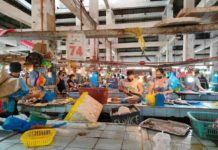
[av_heading tag=’h3′ padding=’10’ heading=’ASEAN ministers’ spouses plant mangroves in Aklan’ color=” style=’blockquote modern-quote’ custom_font=” size=” subheading_active=’subheading_below’ subheading_size=’15’ custom_class=”][/av_heading]
[av_textblock size=” font_color=’custom’ color=”]
Sunday, March 12, 2017
[/av_textblock]
[av_image src=’http://www.panaynews.net/wp-content/uploads/2017/01/planting-copy-1030×652.jpg’ attachment=’99447′ attachment_size=’large’ align=’center’ styling=” hover=” link=” target=” caption=’yes’ font_size=’14’ appearance=’on-hover’ overlay_opacity=’0.4′ overlay_color=’#000000′ overlay_text_color=’#ffffff’ animation=’no-animation’]
Spouses of the Foreign Ministers of Malaysia, the Philippines, Singapore and Vietnam plant mangroves in Boracay Island, Malay, Aklan. Boracay recently hosted several meetings of the Association of Southeast Asian Nations. DENR PHOTO
[/av_image]
[av_textblock size=” font_color=” color=”]
KALIBO, Aklan – The spouses of Foreign Ministers of Malaysia, the Philippines, Singapore, Vietnam and the Secretary General of the Association of Southeast Asian Nations (ASEAN) went mangrove planting at the Sitio Lugutan mangrove site in Barangay Manoc-manoc, Boracay Island, Malay, Aklan, recently.
Aklan Provincial Environment and Natural Resources Office (PENRO) chief Ivene Reyes assisted the ASEAN ministers’ spouses.
He emphasized the importance of mangroves on Philippine biodiversity during the orientation of the participants.
“Mangroves are essential to our coastal areas because they serve not only as breeding ground of sea creatures and birds but also as primary barriers against storm surges and floods,” said Reyes.
Mangroves are trees or plants which grow in the area between the land and water. There are approximately 80 different species of mangrove trees. All of these trees grow in soils which are low in oxygen. Tidal movements vary in these areas, however it results in fine sediments gathering together along the roots.
The tree-planting activity was part of the Foreign Ministers’ spouses retreat program for the ASEAN 50, Philippines 2017 with the theme, “Partnering for Change, Engaging the World.”
“It is an opportune time for us to initiate tree-planting activities to safeguard our environment against natural calamities,” Reyes said.
The planting materials such as stakings, propagules, time of tides and briefing manuals were prepare by the local tourism office of Malay, Manoc-manoc barangay council, and Spouses Program Committee from the Department of Foreign Affairs.
Like coral reefs, mangrove forests are extremely productive ecosystems that provide numerous good and services both to the marine environment and people.
Mangrove forests are home to a large variety of fish, crab, shrimp, and mollusk species. These fisheries form an essential source of food for thousands of coastal communities around the world. The forests also serve as nurseries for many fish species, including coral reef fish.
Meanwhile, mangrove wood is resistant to rot and insects, making it extremely valuable. Many coastal and indigenous communities rely on this wood for construction material as well as for fuel. These communities also collect medicinal plants from mangrove ecosystems and use mangrove leaves as animal fodder.
The dense root systems of mangrove forests trap sediments flowing down rivers and off the land. This helps stabilizes the coastline and prevents erosion from waves and storms. In areas where mangroves have been cleared, coastal damage from typhoons is much more severe. By filtering out sediments, the forests also protect coral reefs and seagrass meadows from being smothered in sediment. (DENR-6/PN)
[/av_textblock]



